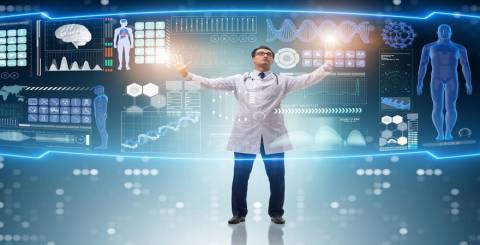Emerging Technological Trends in Healthcare in 2020

Technology has transformed our lives in more ways than one in recent times. It has changed the way we book tickets, order food, do shopping, etc. The healthcare sector is not bereft of its share of impacts due to technological disruptions. Technologies such as AI and Machine Learning have made a foray in the healthcare sector automating various routine processes. We have seen a system of paperless medical records evolving thanks to technology.
As technological innovations continue, we are in for more transformations. The healthcare industry needs to adapt to these changes to enhance the quality of services provided. This is because the patients have access to more information today, their demands have changed. They expect better experience and more visibility.
We are now on the threshold of the year 2020. A much-awaited year because a lot is expected from 2020 thanks to the predictions made by experts in different fields. Of course, we will know what 2020 brings as the year unfolds. But, there are certain technological trends to watch out for in 2020 that the healthcare industry stands to benefit from.
Let us look at some of the technology trends in healthcare in 2020:
Internet of Medical Things
Stats would have us believe that the global IoMT market is expanding at CAGR of 19.9% and is expected to reach a whopping USD 534.3 billion by 2025!
IoMT is essentially an interconnected system of sensors, medical devices, software applications, and healthcare IT systems. This network of systems facilitates testing, monitoring, and diagnostics.
Some examples of applications of IoMT are:
Tracking real-time location
Medical apparatus such as wheelchairs, nebulisers, monitoring equipment, and pumps, etc. are being fixed with sensors which will make it easy to locate them.
Wearable devices
We are all familiar with wearables such as smartwatches, fit bits, etc. for tracking the calories burnt, etc. These are nothing but IoT (Internet of Things) devices. In the medical field, IoMT is being used by sticking plasters, etc. to a patient’s body to monitor his heart rate, blood pressure, body temperature, etc.
The use of such devices is expected to grow. Stats reveal that the wearable industry will be 240.1 million in 2021.
3D Printing
3D printing is used in the medical field to create 3D objects from physical files. This technique helps in providing much closer patient-specific care. 3D printing is a trend to watch out for in the healthcare sector as the global market for it is expected to reach USD 2319.5 Million by 2020.
Natural Language Processing (NLP)
NLP is a branch of Artificial Intelligence that focuses on human-generated written or spoken data.
Some of the applications of NLP include:
- Retrieving the right information from piles of clinical notes.
- NLP along with predictive analysis can help identify high-risk patients. This helps provide them the right treatment on time.
- Helps in summarizing narrative speech to mapping data elements that can be converted from machine-readable form to natural language for reporting and educational purposes.
Machine Learning
This is an upcoming trend that has not yet established itself in the healthcare industry. Machine learning models in different areas of healthcare are in their planning stages currently.
One application of machine learning in healthcare is leveraging medical data through electronic health records to provide better patient outcomes.
As more technological innovations take place, we are sure to witness more changes in the healthcare sector.
With so many innovative developments, the future of the healthcare sector sure looks exciting!
In Conclusion
Adopting new technologies and innovations is the way ahead for the healthcare industry to offer a better experience to the patients. Several organisations across the globe are taking the initiative to drive quality, safety, and safety in healthcare by leveraging information and technology. Events, webinars, Summits etc.are hosted by various healthcare agencies to raise awareness about emerging technologies and how they can be implemented in healthcare. Digital Health Summit 2019 is an example of one such event.
Similar Articles
Choosing the right therapy method can be overwhelming, especially with so many options available today.
In today’s fast-paced world, prioritizing health has never been more important. With increasing access to healthcare programs, individuals can take charge of their well-being, prevent chronic diseases, and promote a longer, healthier life.
Have you considered how remote work affects your mental health? While it offers flexibility, it also brings challenges like isolation, blurred work-life boundaries, and the pressure of managing a flexible schedule, which can impact your emotional well-being.
Seasonal fall allergies are a common problem among people because the sudden change in weather may bring in some allergic reactions. During this time of the year, allergens such as weed pollen, mold spores caused by dampened leaves, and dust mites within homes begin to appear.
Explore how IoT healthcare services are transforming patient care with real-time monitoring, personalized treatments, early detection, and improved telehealth access.
Healthcare facilities provide two types of medical services, i.e. OPD and IPD, where OPD stands for Out Patient Department and IPD stands for In-Patient Department. OPD is a healthcare facility, where patients get medical consultations, diagnosis and treatment within the hospital
Living with any type of disability can often be a challenge while if you are looking for an innovative way to improve your health and well-being, then booking an appointment with an occupational therapist in your local area could just be the solution that you have been looking for.
Discover when your doctor may recommend a hormonal imbalance test to address symptoms like fatigue, weight issues, mood swings, sleep problems, and more.
Prepare for your MRI with ease. Learn what to expect during the scan, how to prepare, and why MRI is key to diagnosing health concerns. Stress-free guidance.









